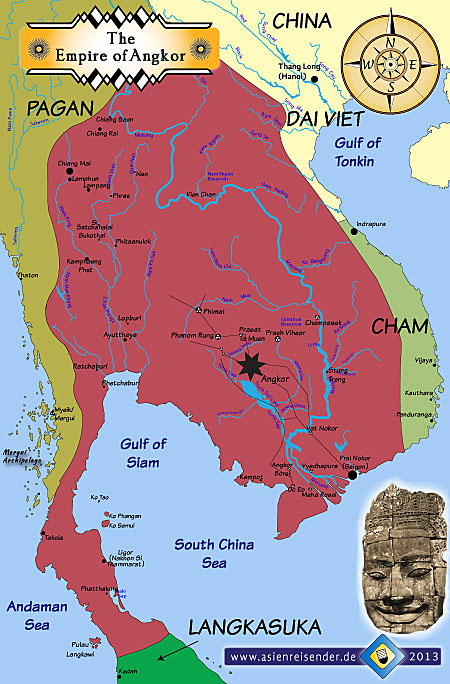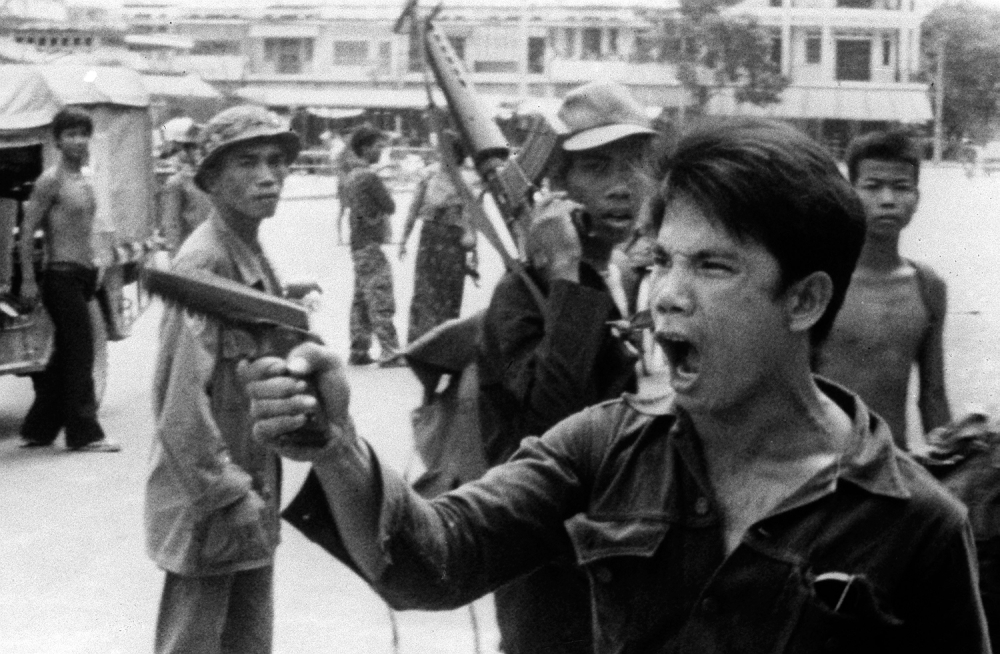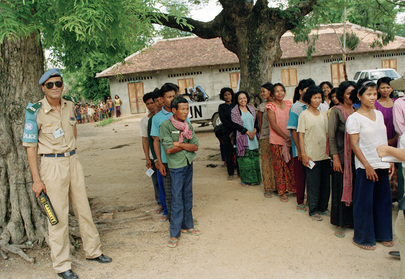History
Cambodia is a fantastic country with a unique culture and very generous people and it is characterized by its significant history of glory and beauty as well as violence and war. The history is an important part of the Cambodian culture and shapes the mindset and thinking of the Cambodian people...

The first known Kingdoms of Cambodia were the Funan and Chanla Kingdom around the first century BC. They were strongly influenced by Indian culture e.g. in the art, architecture, alphabet and political system. However the time in history that many Cambodians often refer to with most pride is the Angkor Empire (9th – 12th Century). By the 12th century, Cambodia had spread into areas now known as Thailand, Laos, Myanmar and the Malaysian peninsular and extensive temples - such as the famous Angkor Wat - palaces and irrigation systems were planned and built.
However by the 13th and 14th century the Angkor Empire declined. Reasons remain unclear; some scholars argue the building programs became too arduous and demanding for the people, so they voted with their feet and left, while others suspect that religion, which demanded such labor from Angkor’s subject, became so corrupt it ultimately corroded the empire from within. During this time, also referred to as the “Dark Ages”, Thai and Vietnamese dynasties invaded and fought over power in Cambodia.
To save his country from eventually being split up between Thailand and Vietnam, King Norodom agreed for Cambodia to become a French Protectorate in 1884. As a colonial power the French mapped Cambodia‘s borders and theThais had to surrender in Battambang and Siem Reap.
During Word War II, in1941 the Nazis invaded France and Japan, as an ally of Germany,occupied the French territories in Indochina and had power over Cambodia. After the Japanese surrendered in 1945, the French came back in force, however, their army had suffered defeats in the Indochina war in the 1950s. Their weakened power and influence strengthened Cambodia in its claim for Independence. The Cambodian King Sihanouk traveled to Thailand, Japan and the United States saying he would not return until his country was free ... and succeeded: On 9.11.1953 – Cambodia became independent from France.
The 1950s and early 60s were a glorious time for Cambodia. The country was politically neutral, had strong economic growth, massive architecture and construction projects, and a booming film and music industry.
This positive trend slowed down in the later 60s. More and more challenges came up: the growing drift between rural farmers and Royal Government and high food prices. When the Civil war started in South Vietnam Sihanouk gave up Cambodia’s neutrality. He supported the rebels (the Vietnamese National Liberation Front) and allowed them refuge in eastern Cambodia.
In 1970, while King Sihanouk was on a visit in Russia, his former army Commander in Chief, pro American Marshall Lon Nol, abolished monarchy and proclaimed a Republic. This was one of the reasons for the rise of the Khmer Rouge (KR). Further causes include: the long years of foreign dependence and control, which also led to Cambodian nationalism; Nixon’s secret Bombing of Cambodia in 1973, in whichmore than 500,000 tons of bombs were dropped on Cambodia to destroy the Ho Chi Minh path and hideouts (in eastern Cambodia); and the Socialist and Communist ideas that the soon to be KR leaders (e.g. Pol Pot) sympathized with strongly when studying in France and joining the French Communist Party.
 Only one week after Lon Nol fled – on April 17th 1975 – the Khmer Rouge marched into Phnom Penh. To make people leave the city, they said that the US planned on bombing Phnom Penh – a quite realistic scenario considering the war going on in neighboring Vietnam. It was the goal of the KR to gain complete political and economical independence and establish a self sufficient agricultural economy. The leaders were speaking about a returning to the past – the year zero. With slogans like “we will burn the old grass and new will grow”, they legitimized the abolishment of everything through the point of view that they were stopping Cambodia from developing its true (communist) potential: money, modern technology, medicine, education and newspapers. For reaching the leaders’ utopist goals, people had to work in the fields without enough food or water, and “enemies of the new state” (teachers, doctors etc.) where tortured and executed. In the 3 years, 8 months and 20 days of the Khmer Rouge Regime, between 1 and 2 million people died, mostly from famine and diseases, but also from torture and execution.
Only one week after Lon Nol fled – on April 17th 1975 – the Khmer Rouge marched into Phnom Penh. To make people leave the city, they said that the US planned on bombing Phnom Penh – a quite realistic scenario considering the war going on in neighboring Vietnam. It was the goal of the KR to gain complete political and economical independence and establish a self sufficient agricultural economy. The leaders were speaking about a returning to the past – the year zero. With slogans like “we will burn the old grass and new will grow”, they legitimized the abolishment of everything through the point of view that they were stopping Cambodia from developing its true (communist) potential: money, modern technology, medicine, education and newspapers. For reaching the leaders’ utopist goals, people had to work in the fields without enough food or water, and “enemies of the new state” (teachers, doctors etc.) where tortured and executed. In the 3 years, 8 months and 20 days of the Khmer Rouge Regime, between 1 and 2 million people died, mostly from famine and diseases, but also from torture and execution.
On the 7th of January 1979, the Vietnamese invaded Cambodia and defeated the Khmer Rouge. The newly installed pro Vietnamese Government, however, was accepted only by a few socialist countries, such as North Korea. Most Nations still saw the Khmer Rouge, who had drawn back to the mountain regions in the north west of the Country, as the leaders of Cambodia. Therefore, the representatives of “Democratic Kampuchea” (Khmer Rouge) kept the Cambodian seats at the UN.
After the Khmer Rouge legacy, a civil war took over the fragile country. Three political camps were fighting over the power in Cambodia: The Khmer Rouge, the followers of King Sihanouk and the Anti-Communists, all of them political enemies of the ruling pro-Vietnamese government.
 In late 1980, peace finally seemed in reach. The now called “State of Kampuchea”, waved goodbye to the last Vietnamese soldiers, which were withdrawn from Cambodia in September 1989. Two years later, in 1991, the peace treaty was signed in Paris, and the UNTAC (United Nations Transitional Authority in Cambodia) was deployed. Another two years later, in 1993, the first Democratic Elections, under the auspices of UNTAC, were held. However, the results showed no clear path yet. The royalist “Funicep” Party and pro Vietnamese “CPP” received an almost equal number of votes, and as a consequence, were supposed to rule Cambodia together. Prince Norodom Ranariddh (Funicep) became first prime minister and Mr. Hun Sen (CPP) second prime mister. An alliance that both parties – due to contrasting interests and priorities - were not satisfied with. The situation resulted in many conflicts and even deaths, and again, a politically unstable Cambodia. In the second elections in1998, this time without foreign observations, the CCP won, and Mr. Hun Sen became the only Prime Minister. A position he has held since.
In late 1980, peace finally seemed in reach. The now called “State of Kampuchea”, waved goodbye to the last Vietnamese soldiers, which were withdrawn from Cambodia in September 1989. Two years later, in 1991, the peace treaty was signed in Paris, and the UNTAC (United Nations Transitional Authority in Cambodia) was deployed. Another two years later, in 1993, the first Democratic Elections, under the auspices of UNTAC, were held. However, the results showed no clear path yet. The royalist “Funicep” Party and pro Vietnamese “CPP” received an almost equal number of votes, and as a consequence, were supposed to rule Cambodia together. Prince Norodom Ranariddh (Funicep) became first prime minister and Mr. Hun Sen (CPP) second prime mister. An alliance that both parties – due to contrasting interests and priorities - were not satisfied with. The situation resulted in many conflicts and even deaths, and again, a politically unstable Cambodia. In the second elections in1998, this time without foreign observations, the CCP won, and Mr. Hun Sen became the only Prime Minister. A position he has held since.
In 2007, the Khmer Rouge Tribunals began, in which six former KR leaders are to be put on trial. Some of the court hearings are open to the public. For information, check the website of the Extraordinary Cambers Court Cambodia (www. eccc.gov.kh)